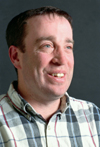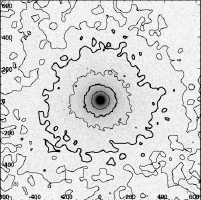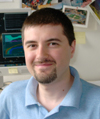 | Wednesday, June 1, 2005 |
|
Wednesday, June 1 THERE WILL BE NO FERMILAB ILC R&D MEETING THIS WEEK 11:00 a.m. Research Techniques Seminar - Curia II Speaker: T. Shutt, Case Western Reserve University Title: The XENON Dark Matter Experiment 2:00 p.m. Proton Driver General Meeting - 1 West Speaker: F. DeJongh, Fermilab Title: e Experimental Ideas Speaker: G. Romanov, Fermilab Title: Front End Design of the Proton Driver 3:30 p.m. DIRECTOR'S COFFEE BREAK - 2nd Flr X-Over 4:00 p.m. Fermilab Colloquium - 1 West Speaker: R. Kaufmann, Boston University Title: Oil and the American Way of Life: Don't Ask, Don't Tell
Thursday, June 2 |
|
Extended Forecast |
Secon Level 3 |
|
Wednesday, June 1 French Onion Soup Texas Style Meatloaf Sandwich $4.85 Grilled Chicken with Black Bean & Corn Salsa $3.75 Kielbasa & Sauerkraut $3.75 Smoked Turkey Panini w/ Pesto Mayo $4.85 Sausage & Pepperoni Combo $3.00 Fettucine Carbonara with Ham & Mushrooms $4.85 The Wilson Hall Cafe now accepts Visa, Master Card, Discover and American Express at Cash Register #1.
Wilson Hall Cafe Menu |
| Fermilab Today is online at: http://www.fnal.gov/today/ Send comments and suggestions to today@fnal.gov Fermilab Today archive Fermilab Today PDF Version Fermilab Result of the Week archive Fermilab Safety Tip of the Week archive Linear Collider News archive Fermilab Today classifieds Subscribe/Unsubscribe to |
|
Rob Roser Named New
Spokesman at CDF Rob Roser begins his two-year tenure today as the co-spokesperson for the Collider Detector at Fermilab, along with Young-Kee Kim. Prior to becoming co-spokesperson, Roser was head of the day-to-day operations of CDF. The new role attracted him because of CDF's unique opportunities in the next few years. "We now have almost ten times the amount of data
Roser will focus on three areas: trying to retain experimenters' connections with CDF before, during, and after the LHC comes online; pushing hard to get results out on time; and encouraging communications between the funding agencies and experimenters. "We don't tell the agencies enough about the successes we have here," Roser said. "We need to make our triumphs more available to everyone."
Roser is from a small town outside Hartford, Connecticut. He conducted
his undergraduate work at the University of Connecticut, with a Ph.D
in high energy physics from the University of Rochester. His favorite
part of working at CDF is the range of personalities and the chance to
work with some of the best minds in the world. "We laugh at each
other sometimes, but we make sure that all the work gets done," Roser said.
|
|
Power Hungry and Waste Wise | ||
| ||
|
The lab uses a vast array of small portable devices that constantly hunger for
more power. To run all of this equipment, each year we consume thousands of
single use batteries that eventually become waste. Recently, all employees
have been required to take a new training class geared toward greater
environmental awareness. This training
encourages us to re-think how we can do our day-to-day business in
a more eco-friendly way. One opportunity to reduce waste is to convert
portable equipment from non-rechargeable to rechargeable batteries when possible.
Several groups have begun making the switch on a common device many people carry daily. Members of both the Accelerator Division and the Computing Division have set up programs that test the use of rechargeable batteries in long-range pagers. With over 1,000 of these pagers assigned to employees, the Business Services Telecommunications group is following the progress to determine if using rechargeable batteries in this type of equipment should be recommended to other users. Other opportunities exist. Many new computers are being purchased with wireless mice and keyboards. Using rechargeable batteries in these devices is an option.
Consider converting to rechargeable batteries. There are a wide range
of battery sizes to fit virtually any application.
Many small devices such as flash lights and many cameras can now be powered
by nickel metal hydride (NiMH) batteries. These batteries are replacing the
more common nickel cadmium (NiCad) rechargeable batteries in many
applications. The most common sizes of
NiMH batteries and battery chargers are now available
in the Fermilab Stock Room. Questions? Contact Eric Mieland
at x2248. |
|
From Rocky Mountain News, May 30, 2005 Colorado site vying for observatory By Associated Press LAMAR - A group of international scientists is expected to decide next month whether to locate a cosmic ray observatory in southeastern Colorado or western Utah. Officials in both areas have been working to land the Northern Pierre Auger Observatory, an international collaboration involving about 300 scientists from 19 countries. The new observatory would work in conjunction with the $55 million Southern Pierre Auger Observatory, which covers 70 square miles in Argentina.
The observatory would be made up of an array of particle detectors spaced one mile apart to measure and study high-energy cosmic rays.
|
|
From Argonne National Laboratory, May 27, 2005 Argonne-designed instruments vital in RHIC discovery ARGONNE, Ill. — Argonne researchers played a significant role in research that led to the surprising finding of a possible ideal liquid instead of the expected quark-gluon plasma at Brookhaven National Laboratory's Relativistic Heavy-Ion Collider (RHIC).
On April 18, each of the four major experiments at RHIC released white papers summarizing the first four years of RHIC operation and their findings from high-energy collisions of gold nuclei. At the incredibly high temperatures and pressures created in the collisions, physicists expected to create “quark-gluon plasma” — a gaseous state of matter thought to have existed in the first few microseconds after the Big Bang. Instead, the matter created inside the detectors behaved like a liquid — a completely unexpected result.
|
|
Wealth of SDSS Data Reveals Invisible Parts of Galaxies, Clusters | ||
One of the most active areas of current astronomical research aims to answer
when structures formed in the universe and how the
gas that was left after the big bang settled into stars, galaxies,
clusters of galaxies, and superclusters of clusters. The broad
picture that emerges is that of "hierarchical clustering": the
smallest galaxies form first and then merge to form larger galaxies
which then fall into clusters. However, six parts out of seven of the
mass in galaxies and clusters is not in the gas and stars whose light
we see, but in dark matter "halos" hosting the stars. These halos are
clouds of particles of hitherto unknown nature, whose presence was
inferred only through the effect of their
However, the details of this process are still subject to debate: How did the dark matter halos merge to form ever larger structures? What exactly happens to a galaxy when it falls into a larger one, or a galaxy cluster? A small team of astronomers headed by graduate student Stefano Zibetti, now a postdoc at Max Planck Institute for Extraterrestrial Physics in Garching, Germany, and Simon White of the Max Planck Institute for Astrophysics also in Garching, have harnessed the statistical power offered by the sheer size of the SDSS to study the distribution of stars in the faintest outer reaches of galaxies and in the intergalactic space in clusters of galaxies. These parts of galaxies and clusters are up to 10,000 times fainter than the sky background light, so that extremely long exposures and extraordinarily careful procedures are needed to detect them in observations of individual objects. Instead, Zibetti and White collected SDSS images of 1047 individual galaxies seen edge-on and scaled, aligned, and added them. They performed a similar analysis for a list of 683 clusters of galaxies provided by Fermilab's Jim Annis. In both cases, the stacking procedure reveals the presence of a faint halo of stars around individual galaxies, and of diffuse stars within clusters of galaxies. The spatial and color distribution of these stars suggest that both stellar halos are formed from the remnants of individual galaxies that were torn apart during their fall into the surrounding dark matter halo. The results have been published in the Monthly Notices in January 2004 and April 2005. | ||
|
Result of the Week Archive |
|
Children's Center 25th Anniversary Reunion and Ice Cream Social All current or former Children's Center students and their families are invited to a Reunion at The Children’s Center (28 Shabbona) on Wednesday, June 1, from 5:30 p.m. to 6:30 p.m. We will celebrate our 25th year by enjoying ice cream and lots of reminiscing. If you plan to attend, please RSVP to Linda Olson-Roach, (630) 840-3082, lor@fnal.gov.
Register for the 2005 Fermilab Users' Meeting
Accelerated C++ Short Course
International Folk Dancing
Fermi Days at Great America in July |



